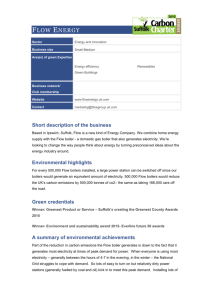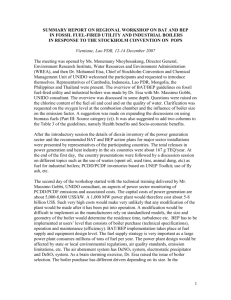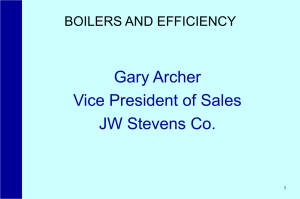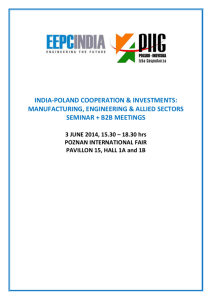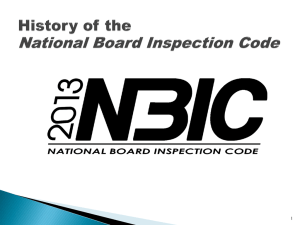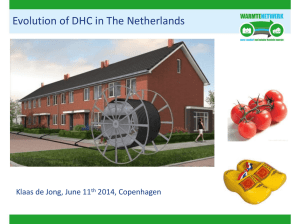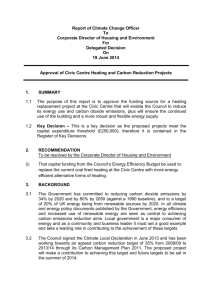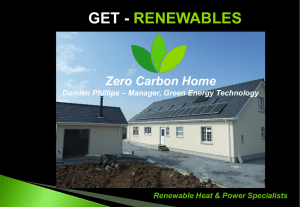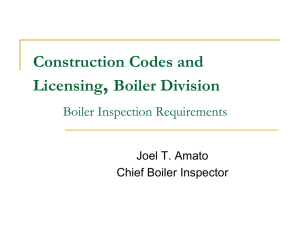Summary of the Air Emission Standards on Thermal Power Plants
advertisement
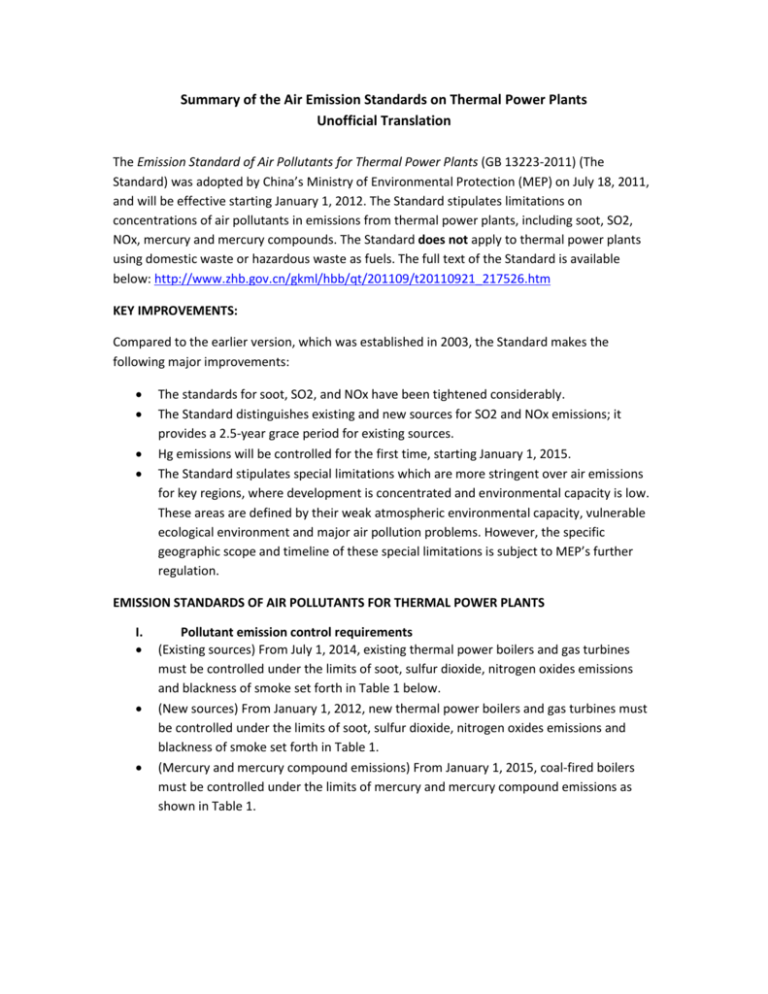
Summary of the Air Emission Standards on Thermal Power Plants Unofficial Translation The Emission Standard of Air Pollutants for Thermal Power Plants (GB 13223-2011) (The Standard) was adopted by China’s Ministry of Environmental Protection (MEP) on July 18, 2011, and will be effective starting January 1, 2012. The Standard stipulates limitations on concentrations of air pollutants in emissions from thermal power plants, including soot, SO2, NOx, mercury and mercury compounds. The Standard does not apply to thermal power plants using domestic waste or hazardous waste as fuels. The full text of the Standard is available below: http://www.zhb.gov.cn/gkml/hbb/qt/201109/t20110921_217526.htm KEY IMPROVEMENTS: Compared to the earlier version, which was established in 2003, the Standard makes the following major improvements: The standards for soot, SO2, and NOx have been tightened considerably. The Standard distinguishes existing and new sources for SO2 and NOx emissions; it provides a 2.5-year grace period for existing sources. Hg emissions will be controlled for the first time, starting January 1, 2015. The Standard stipulates special limitations which are more stringent over air emissions for key regions, where development is concentrated and environmental capacity is low. These areas are defined by their weak atmospheric environmental capacity, vulnerable ecological environment and major air pollution problems. However, the specific geographic scope and timeline of these special limitations is subject to MEP’s further regulation. EMISSION STANDARDS OF AIR POLLUTANTS FOR THERMAL POWER PLANTS I. Pollutant emission control requirements (Existing sources) From July 1, 2014, existing thermal power boilers and gas turbines must be controlled under the limits of soot, sulfur dioxide, nitrogen oxides emissions and blackness of smoke set forth in Table 1 below. (New sources) From January 1, 2012, new thermal power boilers and gas turbines must be controlled under the limits of soot, sulfur dioxide, nitrogen oxides emissions and blackness of smoke set forth in Table 1. (Mercury and mercury compound emissions) From January 1, 2015, coal-fired boilers must be controlled under the limits of mercury and mercury compound emissions as shown in Table 1. Table 1: Thermal Power Boiler and Gas Turbine Air Pollutant Emission Concentration Limits Unit:mg/m3 (not for smoke blackness level ) No. Type of Energy Conversion Facility and Fuel Coal-fired boilers Pollutant Soot Sulfur Dioxide Conditions All New Boiler 1 Existing Boiler 2 Oil-fired boilers or gas turbines Nitrogen Oxides (NO2) Mercury and mercury compounds Soot Sulfur Dioxide Nitrogen Oxides (NO2) 3 Gas-fired boilers or gas turbines Soot Sulfur Dioxide Nitrogen Oxides (NO2) 4 Coal-fired, oil-fired, gas-fired boilers or gas turbines Smoke Degree (Ringelmann Smoke Chart) All All All New boilers and gas turbines Existing boilers and gas turbines New oil-fired boiler Existing oil-fired boiler Gas turbine Natural gas boilers and gas turbines Other gas-fired boilers and gas turbines Natural gas boilers and gas turbines Other gas fired boilers and gas turbines Natural gas boiler Other gas-fired boiler Natural gas turbine Other gas-fired gas turbine All Limits 30 100 200(1) 200 400(1) 100 200(2) 0.03 Location of Emission Control Stack or flue 30 100 200 100 200 120 5 10 35 100 100 200 50 120 1 Stack Vent Notes: (1) to be located in Guangxi Zhuang Autonomous Region, Chongqing Municipality, Sichuan Province and Guizhou Province, where the limits will be implemented with coal-fired boilers. (2) Implementing limits on W-type thermal power generation boilers or furnace chamber flame boilers, circulating fluidized bed (CFB) boilers, and boilers put into operation as of December 31, 2003 or through the construction project’s environmental impact report’s approval of coal-fired power boilers. II. Special Pollutant emission control requirements for key regions Thermal power boilers and gas turbines located in key regions shall implement special air pollutant emission limits set forth in Table 2. The geographic scope of key regions, timeline of the special limits are subject to MEP’s further regulation. Table 2: Special Limits of Air Pollutant Emission Concentration for Key Regions Unit:mg/m3 (not for smoke blackness level) No. 1 Type of Energy Conversion Facility and Fuel Coal-fired boilers 2 Oil-fired boilers or gas turbines 3 Gas-fired boilers or gas turbines 4 Coal-fired, oilfired, gas-fired boilers or gas turbines Pollutant Soot Sulfur Dioxide Nitrogen Oxides (NO2) Mercury and mercury compounds Soot Sulfur Dioxide Nitrogen Oxides (NO2) Soot Sulfur Dioxide Nitrogen Oxides (NO2) Smoke Degree (Ringelmann Smoke Chart) Conditions Limits All All All 20 50 100 All 0.03 All All Oil-fired boiler Gas turbine All All Gas boiler Gas turbine All 20 50 100 120 5 35 100 50 1 Location of Emission Control Stack or Flue Stack Vent III. Environmental departments’ responsibilities over sensitive zones The environmental departments are responsible for environmental quality monitoring in surrounding residences, educational institutions, hospitals and other sensitive areas during the operation of an existing thermal power boiler or gas turbine, and during environmental review upon the completion of a construction project and its subsequent operation. - The range of the monitoring should be the surrounding sensitive zones defined in the EIA of the construction project; - If there has not been an EIA conducted on an existing thermal power plant, the environmental department should act in accordance with the characteristics and nature of the discharge company and the local natural weather conditions and factors, with reference to the environmental impact assessment guidelines. The local government should be responsible for the environmental quality of its jurisdiction and should take measures to ensure meeting the ambient environmental quality standards. IV. The most stringent emission limits should be implemented over emission sources with boilers established at different times, using a hybrid approach for smoke discharge and choosing a monitoring location so that one can only monitor the mixture of air pollutants in the stack emissions.
